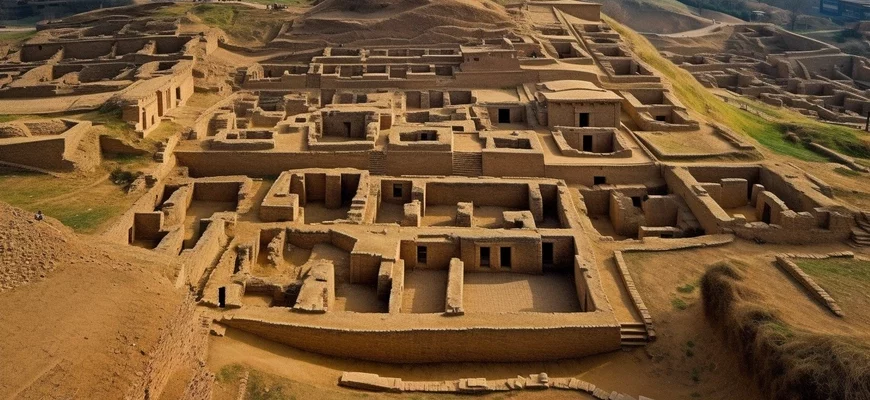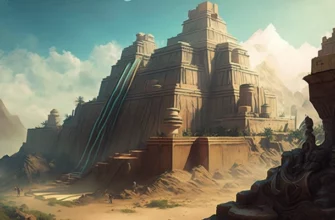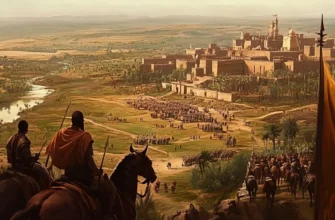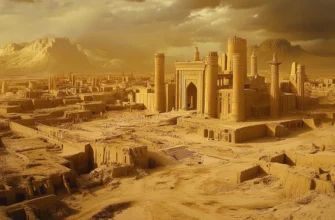Africa is a continent with an ancient history and rich culture. Over thousands of years, dozens of great civilizations have existed on the territory of modern Africa, replacing one another in chronological order.
One of the oldest civilizations is the Kush civilization, which was located in the north of modern Sudan. It existed from 1070 to 350 BC. The Kush civilization was engaged in agriculture and cattle breeding, as well as the development of art, architecture, and religion.
Another important ancient civilization is the Aksumite Empire, which existed in the territory of modern Ethiopia and Eritrea. This empire existed from the 3rd century BC to the 7th century AD. The Aksumite Empire was an important trading center and also had developed architecture and writing.
The third important ancient civilization is the Gan Empire, which existed in the territory of modern Mali and Senegal. The Gan Empire existed from the 8th century to the 14th century. This empire had a developed system of trade and money, and also had a significant influence on the development of art and architecture in Africa.
Despite their achievements, ancient African civilizations were often underestimated and forgotten due to the difficulties of preserving historical sources. However, in recent years,
it has become more important to study the history of these civilizations, as they had a significant impact on the development of culture and science in the world.
For example, the Gan Empire was one of the largest empires in the world at the time and covered an area larger than northern Europe. This empire had a developed road and trade system, as well as a famous gold mine that attracted traders from all over the world. The Ghan Empire also had a developed artistic culture, particularly sculpture and architecture.
Studying the ancient civilizations of Africa also helps to understand Africa’s role in world history and to establish links between these civilizations and other cultures of the world.
In general, the history of Africa is extremely multi-layered and complex, and it has great potential for study and understanding. The study of ancient African civilizations is just one component of this great history that can benefit our world.
- Egyptian Civilization
- History and development
- Culture and religion
- Contribution to world history
- Nubian civilization
- History and development
- Culture and traditions
- Contribution to world history
- Kushite civilization
- History and development
- Culture and traditions
- Contribution to world history
- Aksum civilization
- History and development
- Culture and traditions
- Contribution to world history
- All these achievements made the Aksumite civilization one of the most influential innovative cultures of its time.
- Other civilizations of Africa
- Conclusions
Egyptian Civilization
Egyptian civilization is one of the most famous ancient civilizations of Africa, which emerged around 3150 BC and existed for many centuries.
The Egyptians developed a sophisticated system of writing, architecture, art, and science. They built enormous pyramids, which remain a marvel of engineering technology, and created a complex religious system with over 2,000 gods.
In addition, the Egyptians were known for their achievements in mathematics, astronomy, and medicine. For example, they used a complex system of measuring time based on the solar calendar and developed methods of treating diseases that are still used in modern medicine.
Egyptian civilization also played an important role in world history, particularly in trade and politics. Egypt was an important trading center that facilitated the transport of goods from Africa to Asia and Europe. Egypt was also often chosen as a venue for diplomatic meetings and conferences between states.
Overall, Egyptian civilization was one of the most advanced ancient civilizations in the world, and its achievements are of great importance for the development of science, culture, and technology.
History and development
Egyptian civilization was one of the oldest and most influential ancient civilizations in Africa. It was located on the banks of the Nile River and existed for many centuries, connecting cultures and peoples who traded and entered into political and cultural relations with the Egyptians.
The first settlements on the territory of modern Egypt appeared about 6,000 years ago. In the third millennium BC, the first states, such as Lower and Upper Egypt, emerged in Egypt. Eventually, both states united into a single country ruled by a pharaoh, a ruler with supernatural powers who governed the political and religious affairs of the state.
Throughout their history, the Egyptians developed a complex writing system based on hieroglyphs—symbols that represented words and concepts. They were also known for their achievements in architecture, art, and science. The Egyptians built huge pyramids, temples, and palaces, and crafted intricate objects from precious materials such as gold and stone.
In religion, the Egyptians worshipped many gods and goddesses who ruled over different aspects of life, from the earth and water to the sun and stars.
In the first millennium BCE, Egypt was conquered by the Assyrian Empire and later by the Persians, Greeks, and Romans. During this period, Egypt experienced economic and cultural development and witnessed religious transformations, including the arrival of Christianity in the third century CE.
In the 9th century AD, Egypt was conquered by the Arabs and underwent a significant influence of Islam. Since then, Muslim culture and religion have become major components of Egyptian society. During the Ottoman Empire, Egypt became an important center of trade and cultural exchange between the Eastern and Western worlds.
In the 20th century, after a long struggle for independence, Egypt became an independent republic and sought to modernize and industrialize the country. In recent years, the country has undergone internal political changes, but it retains its cultural and historical significance, attracting thousands of tourists from around the world every year.
Culture and religion
Culture and religion were very important components of Egyptian civilization and its development. The religious system of the Egyptians was very complex and monotheistic, referring to many deities associated with different aspects of nature and life. For example, Ra was the god of the sun, Osiris was the god of the afterlife, and Isis was the goddess of motherhood and femininity.
Many of the religious rituals and practices were related to preparing for eternity, including mummification of the body and the construction of huge pyramids for the pharaohs. Egyptian art was also strongly linked to religion, with many works of art, such as reliefs and statues, depicting deities and religious practices.
In terms of culture, the Egyptians developed their art, architecture, literature, and science. They invented writing, which was a great achievement of their culture, and advanced in astronomy, mathematics, and medicine.
Egyptian culture and religion had a great influence on the cultures of other peoples, including the Greeks and Romans. Their knowledge and achievements have survived to this day and continue to be studied and researched in world history.
Contribution to world history
Egyptian civilization made a significant contribution to world history and played an important role in the development of humanity. Some of Egypt’s most famous contributions to history include:
Development of writing: The Egyptians created their own writing system, which became the basis for the development of writing in other parts of the world, such as the Phoenician alphabet, the Greek alphabet, and the Latin alphabet.
Construction of pyramids: The Egyptians built huge pyramids, which remain some of the most recognizable structures in the world. They are also famous for their precision and complexity in construction.
Development of science: The Egyptians made significant contributions to the development of science, including astronomy, mathematics, medicine, and engineering.
Temple architecture: Egyptian temple architecture was extremely impressive and detailed. Many of their temples, such as the Temple of Amun at Karnak and the Temple of Isis at Philae, are some of the most famous examples of Egyptian architecture.
Religious legacy: The Egyptian religious system and gods had a significant influence on other religious traditions, including Christianity and Islam.
All of these achievements have earned Egypt recognition and respect on the world stage, and its contribution to history remains significant and continues to be studied and researched in world history.
Nubian civilization
Nubian civilization is one of the oldest civilizations in Africa. It is located in southwestern Egypt and northeastern Sudan, in an area covering the Nile Valley. Nubian civilization emerged around the 8th millennium BC and reached its peak in the 4th-6th centuries BC.
The cultural influence of Nubia was evident in art, architecture, religion, and science. Nubian art was known for its frescoes, statues, ritual heads made of rock blocks, decorative motifs on ceramics, and works of art made of stone and metal. In architecture, they built huge temples, palaces, and fortresses.
In religion, Nubian civilization had its own pantheon of gods and goddesses, many of whom were equated with the gods of Egypt. They also believed that their kings were descendants of the gods.
In science, the Nubians were involved in mathematics, astronomy, metallurgy, and stoneworking. They created their own number system based on a 20-year system rather than a 10-year system, as in most cultures.
One of Nubia’s most notable achievements was the creation of the Kingdom of Kush, which existed from approximately 1070 to 350 BC. It was a powerful kingdom that controlled trade with Egypt and other Mediterranean countries and played an important role in the political and cultural life of Africa. Also, during this period, huge pyramids were built, which is evidence of the high level of technology and architectural knowledge of the Nubians.
The Nubians were also known for their understanding of medicine and healing, they knew many plants that had medicinal properties, and they were also skilled in performing complex surgical operations.
In world history, the Nubian civilization left its mark in the form of architectural monuments built during its heyday, as well as in the form of cultural and religious influences on neighboring countries. It was also an important element in the formation of African identity and awareness of the cultural and historical ties between the peoples of the Black Continent.
History and development
The Nubian civilization developed in the Nile River valley in the southern part of modern Egypt and the northern part of Sudan, corresponding to approximately the period from 2500 to 1500 BC. This civilization was interconnected with Egypt and other ancient civilizations of Africa, such as Aksum and Kush.
In the middle of the 2nd millennium BC, the Nubians were engaged in agriculture and crafts. In the 7th century BC, they founded their kingdom, which is usually divided into three periods: the Third Period of Kush (800-400 BC), the Napatan Period (400-275 BC), and the Meroitic Period (275 BC-350 AD). The Napata and Meroitic periods refer to the period of increased influence of Nubia on neighboring countries.
During the Meroitic period, Nubian civilization reached its peak. During this period, the Nubians came into conflict with the Roman Empire, which led to the destruction of their kingdom. After the fall of Meroe, the Nubians continued to live in the region, but their influence declined.
Nubian civilization had a great influence on Egypt and other neighboring civilizations. For example, during the Third Period of Kush, Nubian kings controlled Upper Egypt and introduced their style of art and architecture there.
The Nubians were also known for their technical achievements, including the construction of complex irrigation systems and the production of metal goods. They also used their skills in mining and gemstone extraction.
In the 4th and 5th centuries AD, Nubian civilization underwent a cultural development that was linked to the influence of Islam. The Nubians widely accepted Islam and adapted it to their traditions. Nubian settlements were revived in the 11th-12th centuries AD, when the Nubians repopulated the Nile Valley south of the first cataract.
The Nubians left their mark on world history through their technical achievements, military prowess, and cultural influence on neighboring peoples. Their traditions and culture are still preserved among the modern peoples of Nubia.
Culture and traditions
The Nubians had a developed culture and art, which was linked to their religious and social customs. They created reliefs, sculptures, and images of their gods and goddesses, as well as luxurious jewelry made of gold, silver, and other precious stones.
The traditions and customs of the Nubians reflected their perception of the world and their relationship with nature. For example, they respected water because it was important for their lives and the development of their civilization. The Nubians were also known for their singing and dancing skills.
One of the most famous traditions of the Nubians was the practice of mummification, similar to that of the Egyptians. They believed in life after death, so they mummified their dead to preserve their bodies for the afterlife. In addition, the Nubians had their own religious beliefs and gods, which differed from those of the Egyptians.
The Nubians also differed from other African civilizations in their writing. They used the Nubian language and wrote from left to right. Nubian writing played an important role in preserving their traditions and cultural heritage.
The Nubians are also known for their crafts, such as pottery, weaving, embroidery, and jewelry. They made a variety of jewelry, including beads, earrings, bracelets, and rings from precious metals and stones. In terms of music, the Nubians played a variety of musical instruments, such as drums, flutes, oboes, and lutes.
The religion of the Nubians was strongly linked to their traditions and culture. The Nubians believed in polytheism and had their own gods and goddesses. One of the most important gods in the Nubian religion was Amun, who symbolized creation and dominion over the entire world. Other important gods were Mut, the goddess of love and motherhood, and Khonsu, the god of war and protection.
The Nubians also had their own traditions and customs, which included celebrating weddings, births, and other important events in people’s lives. One of the well-known Nubian traditions is painting geometric and abstract images on the walls of houses to symbolize various aspects of life and religious beliefs.
Overall, Nubian civilization has made a significant contribution to world culture and history, which is still being studied and researched by scientists and historians.
Contribution to world history
Nubian civilization has made a significant contribution to world history, particularly in the fields of architecture and art.
One of the most notable works of Nubian architecture is the Temple of Amun in Napata. The temple was built during the reign of the Napatan kings and was known for its magnificent columns and frescoes. In addition, Nubian sculptors created high-quality reliefs from stone, wood, and clay, which often decorated buildings.
In the field of art, Nubian civilization is known for its luxurious ceramics, engravings, and jewelry, including beadwork and gold jewelry. They were also involved in textiles and silk production.
The Nubians were also known for their military and political strategy. In particular, they played an important role in stopping the Assyrian imperial invasions of Egypt and prevented the Roman Empire from expanding south of the Sahara.
The Nubians also traded actively with various countries, which ensured their wealth and influence in the region. They were important trading partners of Egypt and also traded with various peoples of Central and East Africa.
Thus, the Nubians left their mark on various areas of world history, demonstrating their significant cultural and civilizational heritage.
Kushite civilization
The Kushite civilization is one of the most remarkable ancient civilizations of Africa. It emerged at the mouth of the Nile River in 1070 BC and existed for over 1,000 years.
The history and development of the Kushite civilization are linked to Egypt. In the 8th century BC, after the split of Egypt into two parts, the Kushite rulers conquered Upper Egypt and founded their own dynasty, which opposed the dynasty of the pharaohs in Lower Egypt. During the Kushite period of Egypt, many Egyptian traditions and religious rituals were preserved and studied, which has allowed us to expand our knowledge of the life and culture of the ancient Egyptians.
The Kushite civilization was known for its talented artists, architects, and craftsmen. They created intricate statues and pyramids from granite, as well as various works of metal and glass. Kushite art is known for its differences from Egyptian art, in particular, the use of light colors and simpler forms.
In general, the Kushite civilization was formed on the basis of the traditions of Nubian culture, but over time it became an independent culture, which manifested itself in many aspects of life.
The history of the Kushite civilization begins with the accession of King Alarod I in the 7th century BC. He was the founder of the first Kushite state and managed to establish control over the gold trade with Egypt. Later, the Kushite civilization invaded Egypt and ruled over it from 760 to 656 BC.
The Kushite civilization had a developed architecture, which was manifested in the construction of palaces, temples, and other buildings. The most famous example of architecture is the Temple of Amun in Napata, which was built during the reign of King Pianhih in the 8th century BC.
In Kushite culture, great attention was paid to religion and art. Various materials were used in Kushite art, including wood, stone, and metal. The religious beliefs of the Kushites were associated with the cult of Amun and other gods, who represented symbols of the sun, war, and nature.
History and development
The history of the Kushite civilization can be divided into two eras: ancient and middle. The ancient era of Kush began about 2,500 years ago when this people established their kingdom, which included the territory of modern Sudan and northern Kenya. Much of the excavation related to this era was carried out in the city of Meroe, which became the capital of the Kushite state.
During its development, the Kushite civilization maintained close relations with Egypt. In the 8th century BC, the Kushite king Pianhi conquered Egypt and became pharaoh, beginning the Third Intermediate Period of Egyptian history. This led to mutual influence between the cultures of both states.
In the Middle Kingdom, the Kushite civilization reached its peak. The Kushite kings continued to maintain close relations with Egypt and developed trade with East Africa and Arabia. They also showed considerable interest in architecture and construction, notably creating magnificent pyramids and temples.
During the first millennium CE, the Kushite civilization faced various challenges and crises, including invasions by Christian and Islamic states. The Kushites preserved their culture and traditions, but their state was destroyed as a result of the Arab invasion in the 7th-8th centuries CE.
Culture and traditions
The culture and traditions of the Kushite civilization were greatly influenced by Egypt, but they also had their own characteristics. The Kushites believed in polytheism, in particular, in the goddess Meroe and the god Amun. In addition, they had their own religious rites and ritual sites, including Meroe, where the main shrine of the Kushite civilization was located.
The Kushites had developed ceramics, in particular pottery. They also had a highly developed culture of construction, in particular, they built large palace complexes and temples. They are known to have built tall pyramids, which became known as the Pyramids of Nubia.
The Kushite civilization is also known for its artistic and literary creativity. They produced colorful carpets and textiles, which were highly valued in trade with other peoples.
The Kushite civilization was also famous for its architecture. They built huge temples and palace complexes out of stone and ceramics. Many of these buildings, such as the Temple of Amun in Napata, are still preserved today.
All of this indicates that the Kushite civilization was highly developed and made a significant contribution to African culture and history.
Contribution to world history
The Kushite civilization made a significant contribution to world history, particularly in the fields of architecture, art, and politics.
One of its main contributions was the creation of a center of culture and science in Meroe, where mathematics, astronomy, medicine, and other sciences were developed. Kushite architecture, particularly pyramids and temples, was influenced by ancient Egyptian art but had its own distinctive features and innovations.
In addition, Kushite culture had a significant influence on neighboring peoples, particularly Ethiopian and other African civilizations.
Kushite leaders also played an important role in the politics of the time. For example, Kandaka (Queen) Amanireni was known for her military prowess and leadership skills. She led the Kushite army in battle against the Romans in 27 BC and forced them to retreat from Egypt.
It should also be noted that the Kushite civilization had a great influence on the development of Christianity. According to ancient legends, St. Mary, the mother of Jesus, was in exile in Kush after various persecutions. Accordingly, the Kushite Church was one of the oldest Christian churches in Africa.
Aksum civilization
Aksum civilization is one of the most developed and influential civilizations of Ancient Africa. It appeared around 400 BC in the northwest of modern Ethiopia, in a region known as Tigray. The civilization lasted for more than 1,000 years and left a significant mark on world history.
The history and development of the Aksum civilization are linked to the city of Aksum, which was its center. It was a large city that served as a trading center between the Western world and India for centuries. Thanks to its important geographical position, Aksum became a gold mine for traders who transported Indian spices, honey, ivory, spices, and other goods to the western ports of the Mediterranean.
In the 4th century BC, Aksum became the center of an independent state. While the Roman Empire was in decline, the Aksumite Empire grew in power and influence. During the reign of Meliq Sab’a I of the Adam and Wabi dynasty, the empire reached its peak, opening new trade routes and entering into diplomatic relations with other neighboring countries.
Founded in the 1st millennium BC, the Aksumite civilization (also known as the Aksumite civilization) was one of the most influential states in East Africa. Located in what is now Ethiopia and Eritrea, it existed for over a thousand years and had a significant impact on the development of the region.
The earliest period of the Aksumite civilization, which dates back to the 1st millennium BC, is characterized by the development of agriculture and cattle breeding. In the 2nd-3rd centuries AD, Aksum became one of the most important trading centers, where various cultures, including Indians and Romans, gathered.
In the 4th century AD, the Aksumite civilization reached its peak when the region became the largest and most advanced in East Africa. The Aksumite rulers signed international treaties with the Roman Empire and India, maintaining diplomatic relations and influence over trade.
One of the most important elements of Aksumite culture was their written alphabet, known as Ge’ez. It was the first written alphabet in East Africa and one of the oldest in the world. In addition, Aksumite civilization was known for its artistic crafts, including stone and metalwork.
History and development
The Aksumite civilization was located in what is now Eritrea and northern Ethiopia and existed from around 400 BC to the 7th century AD. Aksum became an important trading center on the east coast of Africa and the Middle East, controlling the transport routes that connected the Dead Sea with India and South Arabia.
In the 3rd century BC, Aksum became a city-state, and in the 4th century, it turned into a large empire that included parts of Saudi Arabia, Yemen, Eritrea, and northern Ethiopia. Axum was famous for its large buildings, such as palaces, cities, temples, and large water storage cisterns.
A significant achievement of the Aksumite civilization was the creation of its own script, known as Ge’ez. This script was used for many centuries in Aksum and other parts of East Africa, and was an important means of communication in the Aksumite Empire.
Religion in Aksum was mainly polytheistic, with a large number of gods and goddesses associated with various aspects of life and nature. However, over time, Christianity became the dominant religion in the Aksumite Empire.
Culture and traditions
The culture and traditions of the Aksumite civilization are reflected in its art, architecture, and religion. The Aksumite civilization had its own symbols and writing system, known as Ge’ez, which was used to write numerous inscriptions on stone and metal.
Aksum art often depicted deities, animals, and humans. Many of these images are found on coins and stone steles, as well as on the walls of buildings. Aksum architecture includes many monumental buildings, such as palaces, temples, and defensive structures, some of which have survived to this day.
The religion of Aksum was strongly linked to the mythology and gods of East Africa, such as the goddess Sawa and the god Mahrem. Many of these gods were depicted as animals, for example, Sawa as a lioness. In their religious practices, the Aksumites practiced animal sacrifice and used fire as a symbol of purity and holiness.
The culture of the Aksumite civilization is also reflected in its trade relations with other countries. Aksum was an important trading center that maintained contacts with the Roman Empire, India, and Persia. Many of the excavations in Aksum have found goods from other countries, such as Chinese ceramics and Indian blankets.
The Aksum civilization had its own cultural traditions and customs. One of the most significant cultural elements was the religious cult of the god Saba, who played an important role in the life of the civilization. Many buildings, such as temples and palaces, were erected in honor of this god. The Aksumite god Saba was known for combining local beliefs with the Christian religion, which came to the region in the 4th century.
In addition, the Aksumite civilization is known for its arts and crafts. Aksum craftsmen produced glass jewelry, ceramics, and pottery, which played an important role in trade with other countries. The metallurgical skills of Aksum craftsmen are also well known; in particular, they produced gold and silver jewelry, as well as coins.
The cultural heritage of the Aksum civilization also includes architectural and engineering achievements. One of the most famous architectural monuments is the Stele of King Ezana, which was erected in the 4th century and is still considered one of the tallest single-stone structures in the world. Another important engineering achievement of Aksum was the creation of an irrigation system for agriculture, which significantly improved crop cultivation and yields.
Contribution to world history
The Aksumite civilization made a significant contribution to world history, especially in the religious and commercial spheres.
Religiously, the Aksumite kingdom adopted Christianity in the 4th century, becoming one of the first countries in the world to do so. Aksum became an important center of Christianity in East Africa and a place of pilgrimage for Christians from various countries.
Trade was also an important part of Aksumite civilization. They controlled the transit trade between India and the Roman Empire and were also known for their production and export of frankincense, gold, and other precious metals.
In addition, the Aksumites invented their own writing system, known as Ge’ez, which was used to record documents, books, and other literary works. This writing system is one of the oldest on the continent.
All these achievements made the Aksumite civilization one of the most influential innovative cultures of its time.
Other civilizations of Africa
In addition to the civilizations we have already discussed, other cultures and peoples developed in Africa that made important contributions to world history. Some of them are:
The Carthaginian Empire: founded in the 8th century BC by Phoenician colonists on the coast of modern Tunisia. Carthage grew into a powerful empire that controlled much of the Mediterranean and traded with the empires of the East and West. In the 3rd century BC Carthage was one of the most influential powers in the world, but was destroyed by the Romans in 146 BC.
Ife: an ancient city-state in southwestern Nigeria, founded in the 9th century AD. Ife was known for its artistic tradition, particularly the creation of exquisite terracotta sculptures. The city was also an important center of the Orisha belief system.
Congo: A state that existed in western Central Africa from the 14th to the 19th century. It is known for its artistic creativity, particularly its bronze art, mask dancing, and oral folk culture.
Zimbabwe: a state that existed in the 13th-15th centuries on the territory of modern Zimbabwe. Zimbabwe is known for its architecture, particularly its huge stone buildings, often referred to as “African pyramids.”
Conclusions
The development of ancient African civilizations was very diverse and spanned the period from 8000 to 1500 BC. During this time, great and significant civilizations flourished in Africa, such as the Egyptian, Nubian, Kushite, Aksumite, and others.
All of these ancient civilizations had a significant impact on world history. Egyptian civilization influenced the development of Greek and Roman cultures and was also an important historical source for Christian and Islamic cultures. The Nubian and Kushite civilizations influenced the culture and development of other peoples in Africa and the Middle East, and also played an important role in the struggle against colonization.
The ancient civilizations of Africa had impressive achievements in architecture, art, science, and technology, which significantly influenced world history. Each of these civilizations had its own unique characteristics, culture, and traditions, as well as its own contribution to world history.
Egyptian civilization was one of the most influential ancient civilizations in the world. It developed on the banks of the Nile and left behind a vast number of architectural, artistic, and scientific achievements. The Nubian civilization, particularly the Kingdom of Meroe, also had a significant impact on the development of African and world history, particularly in the fields of metallurgy and ceramics.
The Kushite civilization was an important political and cultural center in Africa, which played an important role in restoring cultural and economic ties between the eastern and western regions. The Aksum civilization is known for its great wealth and developed trade network, which included India, the Roman Empire, and Persia.
The development of ancient African civilizations was diverse and unique, but they all had one thing in common: they contributed to world history, and their achievements remain impressive to this day.








